BUDDLEIA : Buddleja davidii
Also known as the Butterfly bush because, as the name suggests of its attractiveness to butterflies. It is a much favoured popular species for garden plant.
Buddleia is a familiar sight around West Dunbartonshire. it is a popular plant for gardens with its with large, drooping spikes of densely clustered, small, purple (or sometimes white) flowers. It has long, narrow leaves and the flowers have a honey-like fragrance.
And butterflies love it.
So why is referred to as an INVASIVE SPECIES? See index.asp?pageid=732296
A quick look at the internet and we immediately notice two references to it being problemmatic. The Wildlife Trusts note that it is actually an introduced species, however, that has become naturalised on waste ground, railway cuttings and in towns.
The BBC takes a stronger line terming it The plant that dominates Britain's railways. The BBC's Tanya Gupta writes :
More people are buying buddleia for their gardens, but it's classified as an invasive species and is a problem on British railways.
It's hard to walk by a railway line in Britain and not see buddleia.
Along fences by the tracks and almost any patch of waste ground, you will notice the long, slender clumps of flowers, usually lilac but also blue, deeper purple or white, at the end of long, arching branches.
BBC weather forecaster Peter Gibbs says the mild, wet winter will have improved germination and growth this year, especially in areas where water normally drains away quickly, such as derelict urban sites. "Buddleia is an opportunist that's always ready to capitalise on any slight advantage."
Sprouting from seemingly every derelict building, it stakes an increasingly plausible claim for the title of Britain's national flower.
And sure enough, there it is clinging to the railway viaduct as it passes Alexandria (amongst other places) alongside the Leven.
It is not uncommon to see plants get a grip on stonework, but to see such large ones as these is impressive. The roots of some plants can actually prise stonework apart as they grow. It is not known if this is the case with buddleia, but we would have imagined more caution and its eradication here. For some reason it seems to prefer growing from stonework and masonry than open soil and other examples can be found in places such as Lomond Industrial Estate.
Buddleja is thought to be a native plant to China and also to other places with similar climates such as Africa.
The Property Care website puts it this way : Second only to Japanese knotweed, Buddleia is probably the best-known invasive plant/weed in the UK. Brought to the UK from China over 100 years ago, It is sometimes said to be beneficial to wildlife as it is very attractive to butterflies, but this is only true for the adults because there are no native species that lay their eggs on buddleia or use it as a food source for caterpillars. And In severe cases, buddleia roots can colonise masonry walls making them somewhat unstable and a potential danger as well as blocking gutters and causing rainwater to penetrate walls. [Property Care].
Further warnings about it came in May 2024 (actually it is a seasonal warning).
The buddleia shrub, also known as the butterfly bush, is bursting with stunning flowers and attracts butterflies, birds and bees, making it a much-loved choice by many. But while it may look harmless, according to experts it can be so lethal, it can even even devalue your home. That's because the invasive plant, which is often found in UK gardens, spreads its seeds to fast, it can quickly find itself spreading to areas its not wanted - including walls, roofs and windowsills, according to experts at GardenBuildingsDirect.co.uk. With the roots strong enough to penetrate buildings, buddleia is capable of inflicting "costly damage" and devaluing properties as a result.
The plant was named after Botanist Reverend Adam Buddle, who first introduced in England. The plant was named in his honour after his death in 1715.
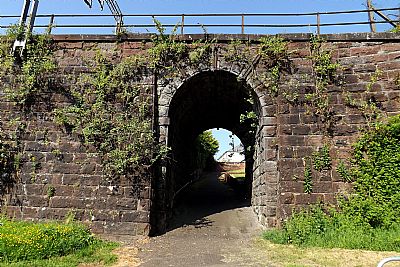
Buddleia gripping onto the railway viaduct at Alexandria.
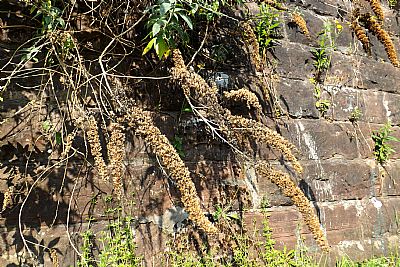
Last year's dry flower heads in June; every part a seed.
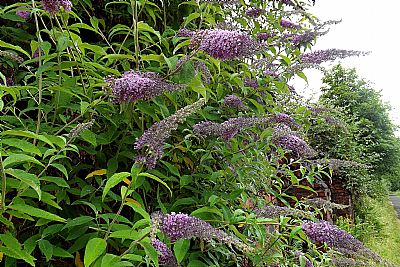
With some dry seed heads from last year still visible, these bushes undergo a complete transformation in late June with many new flower heads.
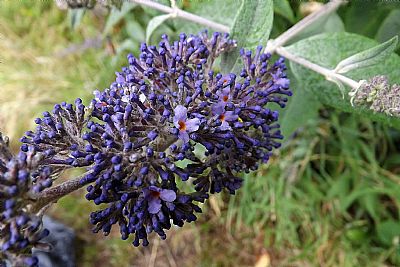
The flower heads comprise many flowers ranging from blue to purple.
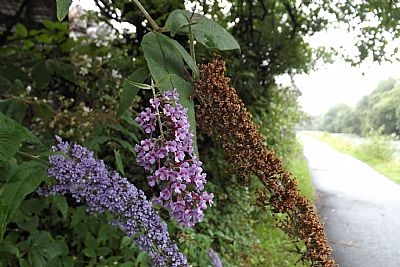
During mid-July there are still new flowers growing alongside slightly older ones, while some have gone completely to seed already.

In this picture taken in July 2023, you can see this plant happily spreading even more across the masonry. Compare this to the first photo to see the extent of its increased growth this year.
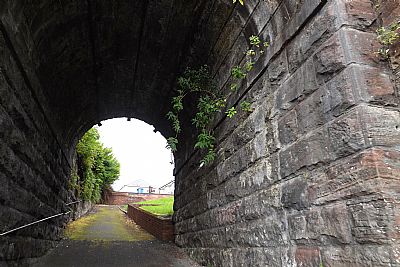
And it doesn't even need direct rain. These plants within the underpass are watered by the seepage from the track above.
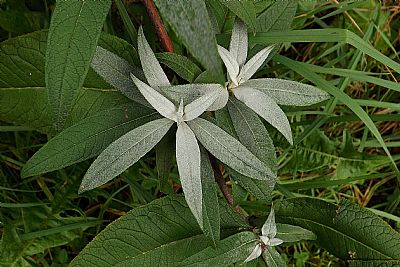
Silvery new leafs of buddleia in October.
A RETHINK?
So there you have it. Buddleias are extremely problematic and need to be avoided at all costs. Removed without trace. Despised.
So why do they appear in the August 2024 issue of Gardeners' World?
Well there are now varieties available that do not proliferate uncontrollably as do the "wild" species. The article written by Graham Rice refers to a company that specialises in invasive species control which claims that buddleias are "undergoing a reputation reconstruction".
Science has come to the rescue. In this instance this is not to do with eradication, but the production of new varieties that satisfy the gardener without the threat of runaway seeds. These new varieties come with such attractive names as "Miss Ruby", "Blue Chip", "Black Knight", "Santana" and "Buzz Series", the names giving clues as to their colours which vary from very much like the original one to reds and whites.
The article does carefully note that the new non-invasive varieties are too new to properly assess, but whether that is from a point of view of a garden designer or species control, we are not sure. Anyway they are said to not disperse seeds, at least in such massive numbers.
The article also suggests that if you do have the original buddleia and do not want to completely obliterate it, make sure you deadhead thoroughly as soon as the flowers start to wither.
Time will tell.
In the meantime though, while buddleia davidii is not actually banned, it is recognised as extremely problematic. It is surprising then to see it offered by notable nurseries and online sources such as Thompson & Morgan, Gardening Express and also Amazon. These include the original variety and also some that have variations in colour and bloom size. If you do pick one of these, it is recommended that you clarify with the seller how controlable these are and how.
DAILY EXPRESS : article by Sophie Harris. 20th May 2024. https://www.express.co.uk/life-style/garden/1901403/invasive-weeds-buddleia-house-value-garden
INVASIVE WEED SOLUTIONS : https://invasiveweedsolutions.co.uk/invasive-weeds/non-native/buddleja/
PROPERTY CARE ASSOCIATION : https://www.property-care.org/homeowners/advice/invasive-weeds/buddleia
RICE, GRAHAM, Buddleias, Gardener's World (BBC). August 2024. P15.
WILDLIFE TRUSTS : https://www.wildlifetrusts.org/wildlife-explorer/trees-and-shrubs/buddleia

